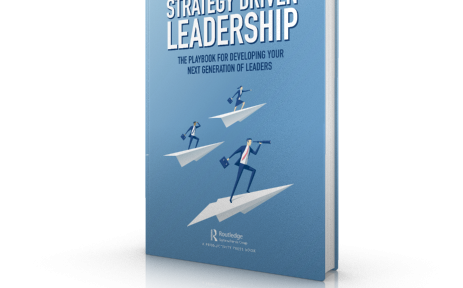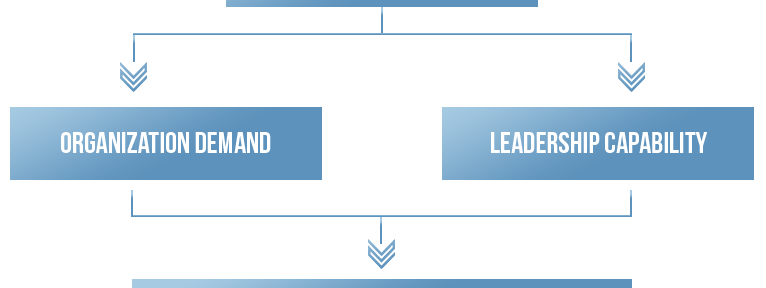How are you developing your new leaders?
If you are like most companies, your approach is haphazard at best.
- Maybe you looked at seniority?
- Or who is a good performer?
- Perhaps someone who scored well on an assessment that predicted their success?
One day you turn around and noticed that people just ascended into new leadership roles because…you don’t really know….
If any of these perspectives describes your company, then our ideas about Strategy Driven Leadership Development are for you. This approach, detailed in my new book, co-authored with Michael Couch catalogues the research and solutions for finding and generating great leaders for your company
They are detailed out in our new book Strategy Driven Leadership: The Playbook for Developing Your Next Generation of Leaders.
It is time for a complete make-over of the approach
used to create the leaders needed in today’s volatile,
uncertain, complex, and ambiguous business world
and the graphic below describes it:


Growing your business begins with your strategy and for many organizations, they are pretty good at building their plan. Unfortunately, for many, that is where it ends.
What separates high performing organizations from average firms is how they put their strategy into play. To make that happen, your people need the skills and competencies to create leadership success and operational excellence.
Here are some questions you should consider as you build your strategy
- What are our key markets? Is our plan to grow, hold share or harvest in each?
- Who are our major competitors and what is our competitive advantage (or disadvantage) compared them?
- What are our key performance indicators and what has been their trend?
- What are the existing and future organization capabilities (structures and processes) that the organization must possess to successfully execute its strategy? Which are declining in relevance?
- What are our core value streams and which functions play a central role in them?
- Does the strategy specifically address buying, building, or redeploying talent to achieve strategic goals and objectives?
- And finally, what are the key challenges that leaders must address to successfully execute the strategy?
To move towards strategy implementation, the first step is to determine the “demand” or requirements that the strategy puts on the organization. These demands, which we refer to as “mission critical skills” can be thought of as the competencies required to meet the strategy and they are different based on the business’s strategic requirements. For example, if your business in in a turnaround mode, that requires one set of skills but if you are planning a major reorganization and realignment of business units, then a different set of skills are required.
Identifying mission-critical skills has been described as both an art and a science. My belief is that it is more on the science side than some would have you believe. Given that the practice of using competencies in building talent, we know a lot more about this then we usually give ourselves credit for knowing. As we build your list of strategy-critical competencies, we focus on the following ideas.
- Model top-notch performance in your organization
- Don’t look to what happened in the past, set the stage for the future
- Use a standardized set of skill or competency descriptors
- Model roles and processes, don’t focus on jobs and departments
- Align and integrate all your required competencies to the strategy
- Make the model accessible to all your key employees
- Keep it simple
Capabilities
Now that you know what the organizational demands the business strategy puts on the business, it is time to turn to identifying and assessing the capacity of leaders and managers at all levels to see if your people can meet the challenge.
The purpose of assessing your talent is two-fold:
- Understanding the overall capability of your talent and whether you have the talent
necessary to execute your strategy - Identifying the most effective and powerful way to develop your leaders who would most benefit the organization’s strategy success.
A variety of criteria have been used over the years to describe organizational capability and the capacity of leaders to assume larger and broader roles that will drive strategic success. The most common criterion, in the past, was based on performance in a specific role. While performance is important, the truth is that “what got you here, won’t get you there.”
We like to think about capability from another perspective. The key to taking on bigger and broader roles within an organization is all about creating a growth mindset and assessing talent based on their growth potential, their willingness to take on hard tasks and challenges and providing the opportunity to give people experiences from which they can add to their existing repertoire of skills. It’s about an individual’s ability over time to adjust to new demands, learn quickly from new experiences and build his or her repertoire of leadership competencies.
Development
Being intentional is about being deliberate and purposeful in what you do. Most organizations fall into routines that takes them from meeting to meeting, from fire to fire and from idea to idea.
Organizations grow when their leaders find time to think, create ideas that solve problems and grow their next generation so that they are ready to continue to build success.
Any organization can build an intentional development plan by following these 3 key steps:
- Create Mass Personalization: One size programs do not meet the needs of your leadership team. Remember that strategy is different at different times and for different roles and you will want to customize the development for each and every employee.
- Build it In, Don’t Bolt It On: Leadership development does not happen during the 9-11 timeslot when training programs occur but in everyday situations that happen every day!. Leadership growth happens as work happens.
- Create a Feedback Rich Environment: Our brains are much more attuned for negative feedback than positive feedback. objective, targeted and requested feedback that comes from a variety of sources provides the best way for people to integrate learning experiences into new behaviors.

